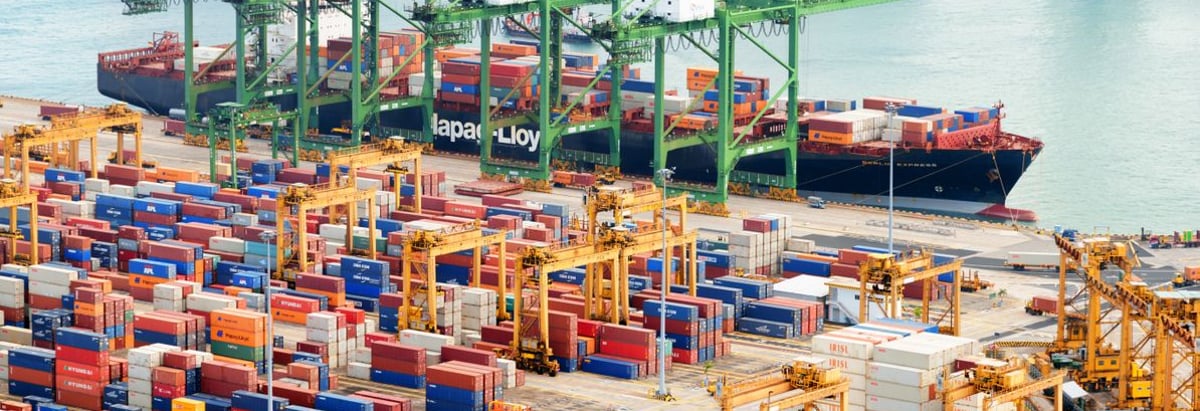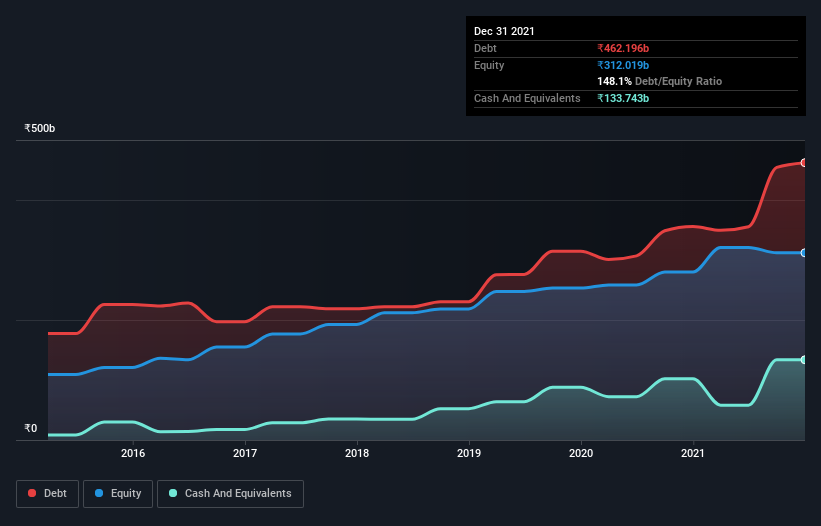- India
- /
- Infrastructure
- /
- NSEI:ADANIPORTS
These 4 Measures Indicate That Adani Ports and Special Economic Zone (NSE:ADANIPORTS) Is Using Debt Reasonably Well

David Iben put it well when he said, 'Volatility is not a risk we care about. What we care about is avoiding the permanent loss of capital.' It's only natural to consider a company's balance sheet when you examine how risky it is, since debt is often involved when a business collapses. Importantly, Adani Ports and Special Economic Zone Limited (NSE:ADANIPORTS) does carry debt. But is this debt a concern to shareholders?
When Is Debt Dangerous?
Debt is a tool to help businesses grow, but if a business is incapable of paying off its lenders, then it exists at their mercy. Ultimately, if the company can't fulfill its legal obligations to repay debt, shareholders could walk away with nothing. While that is not too common, we often do see indebted companies permanently diluting shareholders because lenders force them to raise capital at a distressed price. By replacing dilution, though, debt can be an extremely good tool for businesses that need capital to invest in growth at high rates of return. When we think about a company's use of debt, we first look at cash and debt together.
See our latest analysis for Adani Ports and Special Economic Zone
How Much Debt Does Adani Ports and Special Economic Zone Carry?
You can click the graphic below for the historical numbers, but it shows that as of September 2021 Adani Ports and Special Economic Zone had ₹462.2b of debt, an increase on ₹355.9b, over one year. However, because it has a cash reserve of ₹133.7b, its net debt is less, at about ₹328.5b.

How Healthy Is Adani Ports and Special Economic Zone's Balance Sheet?
According to the last reported balance sheet, Adani Ports and Special Economic Zone had liabilities of ₹111.9b due within 12 months, and liabilities of ₹419.0b due beyond 12 months. On the other hand, it had cash of ₹133.7b and ₹36.7b worth of receivables due within a year. So it has liabilities totalling ₹360.4b more than its cash and near-term receivables, combined.
While this might seem like a lot, it is not so bad since Adani Ports and Special Economic Zone has a huge market capitalization of ₹1.50t, and so it could probably strengthen its balance sheet by raising capital if it needed to. But it's clear that we should definitely closely examine whether it can manage its debt without dilution.
We use two main ratios to inform us about debt levels relative to earnings. The first is net debt divided by earnings before interest, tax, depreciation, and amortization (EBITDA), while the second is how many times its earnings before interest and tax (EBIT) covers its interest expense (or its interest cover, for short). The advantage of this approach is that we take into account both the absolute quantum of debt (with net debt to EBITDA) and the actual interest expenses associated with that debt (with its interest cover ratio).
Adani Ports and Special Economic Zone has a debt to EBITDA ratio of 3.5, which signals significant debt, but is still pretty reasonable for most types of business. But its EBIT was about 10.1 times its interest expense, implying the company isn't really paying a high cost to maintain that level of debt. Even were the low cost to prove unsustainable, that is a good sign. Also relevant is that Adani Ports and Special Economic Zone has grown its EBIT by a very respectable 28% in the last year, thus enhancing its ability to pay down debt. When analysing debt levels, the balance sheet is the obvious place to start. But ultimately the future profitability of the business will decide if Adani Ports and Special Economic Zone can strengthen its balance sheet over time. So if you're focused on the future you can check out this free report showing analyst profit forecasts.
Finally, a company can only pay off debt with cold hard cash, not accounting profits. So we clearly need to look at whether that EBIT is leading to corresponding free cash flow. During the last three years, Adani Ports and Special Economic Zone produced sturdy free cash flow equating to 79% of its EBIT, about what we'd expect. This cold hard cash means it can reduce its debt when it wants to.
Our View
Adani Ports and Special Economic Zone's conversion of EBIT to free cash flow suggests it can handle its debt as easily as Cristiano Ronaldo could score a goal against an under 14's goalkeeper. But truth be told we feel its net debt to EBITDA does undermine this impression a bit. It's also worth noting that Adani Ports and Special Economic Zone is in the Infrastructure industry, which is often considered to be quite defensive. Looking at the bigger picture, we think Adani Ports and Special Economic Zone's use of debt seems quite reasonable and we're not concerned about it. While debt does bring risk, when used wisely it can also bring a higher return on equity. When analysing debt levels, the balance sheet is the obvious place to start. However, not all investment risk resides within the balance sheet - far from it. Case in point: We've spotted 3 warning signs for Adani Ports and Special Economic Zone you should be aware of, and 1 of them makes us a bit uncomfortable.
If you're interested in investing in businesses that can grow profits without the burden of debt, then check out this free list of growing businesses that have net cash on the balance sheet.
If you're looking to trade Adani Ports and Special Economic Zone, open an account with the lowest-cost platform trusted by professionals, Interactive Brokers.
With clients in over 200 countries and territories, and access to 160 markets, IBKR lets you trade stocks, options, futures, forex, bonds and funds from a single integrated account.
Enjoy no hidden fees, no account minimums, and FX conversion rates as low as 0.03%, far better than what most brokers offer.
Sponsored ContentNew: Manage All Your Stock Portfolios in One Place
We've created the ultimate portfolio companion for stock investors, and it's free.
• Connect an unlimited number of Portfolios and see your total in one currency
• Be alerted to new Warning Signs or Risks via email or mobile
• Track the Fair Value of your stocks
Have feedback on this article? Concerned about the content? Get in touch with us directly. Alternatively, email editorial-team (at) simplywallst.com.
This article by Simply Wall St is general in nature. We provide commentary based on historical data and analyst forecasts only using an unbiased methodology and our articles are not intended to be financial advice. It does not constitute a recommendation to buy or sell any stock, and does not take account of your objectives, or your financial situation. We aim to bring you long-term focused analysis driven by fundamental data. Note that our analysis may not factor in the latest price-sensitive company announcements or qualitative material. Simply Wall St has no position in any stocks mentioned.
About NSEI:ADANIPORTS
Adani Ports and Special Economic Zone
Operates and maintains port infrastructure facilities in India.
Solid track record average dividend payer.
Similar Companies
Market Insights
Community Narratives




